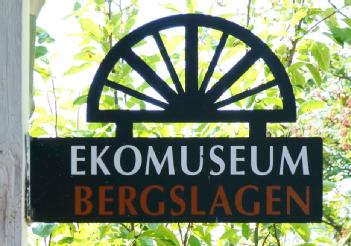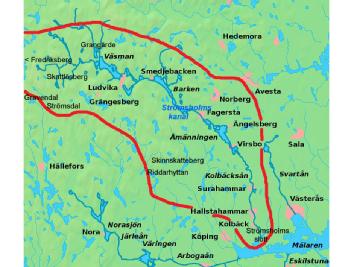
Ekomuseum Bergslagen |
77153 Ludvika, Sweden (Dalarna) |
|
| Address |
Nils Nils gata 7
Stiftelsen Ekomuseum Bergslagen |
| Floor area | only roughly guessed: 750 000 000 m² / 8072 932 813 ft² |
Open Air Museum
- Navy / Watercraft
- Mining
- Architecture
- Railway
- Hydropower or muscle pumps
- Industry / Production Technology
- World Heritage Site
|
Opening times
|
|||||||||
|
Status from 12/2019
|
We don't know the fees. | ||||||||
| Contact |
|
||||||||
| Homepage | ekomuseum.se | ||||||||
| Location / Directions |
Ecomuseum Bergslagen is an open-air museum in the western part of the former mining and smelting region of Bergslagen in central Sweden. The museum opened in 1986 and is today the world's largest ecomuseum. The museum is a joint project of the municipalities Ludvika, Smedjebacken, Fagersta, Norberg, Skinnskatteberg, Surahammar and Hallstahammar. Ecomuseum Bergslagen is a 750 square kilometre area reaching from Lake Mälaren in the south to Forest Finns forests in the north. It takes about three hours by car to travel from north to south and the visitors travel on their own through the landscape. |
|||
| Location / Directions (other) |
Ekomuseum Bergslagen är ett ekomuseum och ett decentraliserat friluftsmuseum i Bergslagen. Museet började sin verksamhet 1986 genom ett samarbete mellan kommuner och länsmuseer i området. Det räknas idag till världens största ekomuseum.
Det gemensamma temat är järnets historia. Ekomuseum Bergslagen består av ett 60-tal besöksmål som belyser järnhanteringen och järnets väg på olika sätt från kolproduktionen och gruvor, hyttor och järnbruk i norr och, med Strömsholms kanal som transportled, ner till Mälaren i söder. OmrådetEkomuseum Bergslagen knyter samman en lång rad besöksmål i Västerbergslagen. Det gemensamma temat är ”järnets historia” med fokus på teknik, människans villkor, transportvägar och de naturresurserna som fanns att tillgå. Området sträcker sig från Grangärde finnmark i norr, där skogsfinnar producerade träkol för hyttor och smedjor, ner till Mälaren och Borgåsunds hamn i söder, där järntackor och stångjärn lastades om för vidare transport till Stockholm. Bergslagens järn, koppar- och silverhantering var av mycket stor ekonomisk betydelse för Sverige. Som en röd tråd drar sig transportleden Strömsholms kanal genom området.Området är stort, cirka 750 kvadratkilometer utställningsytor, och det tar ungefär tre timmar att köra med bil från Fredriksberg i norr ner till Strömsholm vid Mälaren i söder. |
|||
| Description | From Wikipedia, the free encyclopedia: You can follow the history of mining for more than 2000 years – from 400 BC until today. Ekomuseum Bergslagen shows mythical pre-historic ironwork sites with historical blast furnacees and smithy, rolling mills, and modern steel businesses along the vital transportation route, the Strömsholms Canal. But also castles, such as Strömsholm Palace, workers' homes in Ludvika and Grängesberg and Forest Finns simple settlements and cottages near Grangärde. The museum includes several mining areas, local museums, electric power stations, historical railways (Engelsberg-Norberg Railway), and a historical railway museum (Railway museum Grängesberg). One of the attractions is Lapphyttan in Norberg Municipality, may be regarded as the type site for the Medieval Blast Furnace. Its date is probably between 1150 and 1350. It produced cast iron, which was then fined to make ferritic wrought iron cake or bun-like blooms. Another attraction is Engelsberg Ironworks (Swedish: Engelsbergs bruk), an ironworks in Ängelsberg. It was built in 1681 and is listed as a UNESCO world heritage site since 1993. Destinations Ludvika Smedjebackens more Destinations see Besöksmål |
| Description (other) |
Destinations - Besöksmål Norbergs Thorshammars verkstad Fagersta Skinnskattebergs Hallstahammars |
[dsp_museum_detail.cfm]
| Data Compliance | More Information |

 ekomuseum.se
ekomuseum.se 
